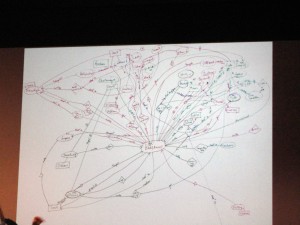Netcologies
“This weekend, I attended yet another conference – this time the Ecology of Networks Symposium held at Duke University (affectionally dubbed “#netcologies” for the livetweeters). The conference was an interesting affair that basically brought folks from every discipline under the sun together to talk about how they interpret and deal with networks in their field, from computer science to genetics to artwork. It was engaging and somewhat provocative, starting off fairly concretely in the morning and drifting into the curious and bizarre by the end of the night.
Originally, I was approached by Amanda to write some about my work in networks, and considering that the topic I had in mind was not specifically addressed during the symposium, I feel genuinely awful for flaking out. Much of the talks emphasized the connectedness of networks – networks as wholes of information that offer a very clear big picture that can’t be seen from the point of view of an individual node. It’s a shame, then, that the point of view of the individual node was not addressed. In a technical sense, working in networks has a lot of uncertainty. We have protocols like ethernet and WiFi that allow our networked devices to communicate, but they have to trust other devices not to violate the protocol in their own self-interest. Nodes have to trust one another in order to work together, and in many cases there isn’t much holding back bad behavior.
The first rule of making a website is to treat every visitor as an enemy and make sure they can’t break your website. In peer-to-peer networks, such as in social media or multiplayer computer games, this doesn’t necessarily work, so you have to make some concessions in order to be a part of the whole – is this other actor playing by the rules? What is the risk for communicating with it? This is touched on slightly by the very first talk of the session, when talking about policy-based networks, but what about emergent networks without hierarchies where a policy can not be encoded and enforced across the entire ecosystem?
Networks are inherently unreliable, so the most we can assume is that the network will make its “best effort” to deliver and receive information. When it comes to programming a node, this uncertainty drives nearly every decision – how often do we check for data? When do we assume we have been disconnected? How do we ensure we are actually talking to who we say we are, and not talking through a malicious eavesdropping intermediary? The talk that got the closest to this idea was the one around the Alternate Reality Game, Speculat1on, where the people participating in the game are no longer sure what is part of the network and what isn’t.
This isn’t to say that I was unhappy about the talk of positive and productive networks. My favorite talk of the entire show was by Patrick LeMieux on the networks of people behind who play games. Despite games being ostensibly a participatory medium, they are treated by their publishers as very one-directional things to be consumed. They can be engaged, but only in the appropriate channels, with modded consoles being banned from the Internet and modders even being sued.
In spite of this, people find ways to turn games into platforms upon which to develop new games, from speedruns of the original Mario Brothers game to the creation of chimeras that use the output of one game as the input of another. What was once simply a game to be played by oneself has become an ingredient in artwork that transcends the rules of games. While I believe in games as systems of rules that define a space (basis behind my research), these are the sorts of emergent “play” that transcends the games’ rules entirely. People are so fascinating.
This was a fun diversion! I met some interesting scholars and look forward to seeing how the digital publication of this work manifests itself. One them that was certainly dominant was the idea of networks as nonlinear modes of interacting and producing information, and it’s only appropriate that the final work will be published as a networked document on Scalar. A big takeaway from this symposium is that the network of interactions of content are worth as much if not more than the content itself, something that hits home for me as it serves as the foundation of educational data mining.”
Thanks to Barry Peddycord III (perhaps better known as @isharacomix) for the fantastic post-symposium post!
asg









